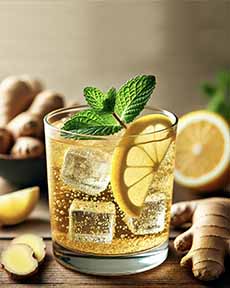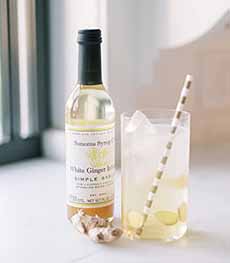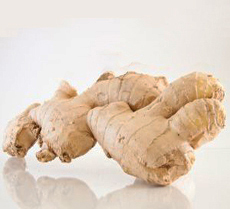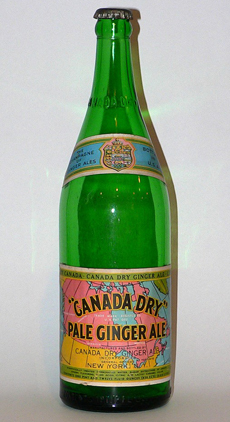TIP OF THE DAY: Homemade Ginger Ale & The History Of Ginger Ale
|
March 13th is National Ginger Ale Day, time to enjoy a refreshing glass of ginger ale. You can buy a commercial brand, of course; but for something special, you can purchase ginger syrup and add it to club soda. If you like a hot and spice sizzle, pick up some ginger beer syrup. The syrups can also be used to flavor barbecue sauce, cocktails, desserts, dips, dressings, glazes, iced tea and other foods and beverages. Or, make your own ginger ale from scratch, using fresh ginger root simmered in water. The flavor is so much more vibrant: It sizzles. And, since St. Patrick’s Day is this week, you can color it green! We adapted this recipe from Epicurious. A squeeze of lime juice, not an ingredient in conventional ginger ale, adds terrific flavor complexity. The recipe makes about 1-1/2 cups syrup, enough for 4 to 6 drinks. Prep time is 10 minutes, total time including chilling is 3 hours. Ingredients 1. MAKE the syrup: Over a low simmer, cook the ginger and water in a small saucepan, partially covered, for 45 minutes. Remove from the heat and let the ginger steep, fully covered, for 20 minutes. 2. STRAIN the mixture into a bowl, pressing on the ginger to extract all liquid; then discard the ginger. Return the liquid to the saucepan, add the sugar and salt, and cook over medium heat, stirring, until the sugar has dissolved. 3. CHILL the syrup in a covered jar until cold. To make ginger ale, mix 1/4 cup of ginger syrup with 3/4 cup club soda and 1-1/2 teaspoons lime juice. Taste and adjust the proportions as desired. Use up the syrup within one week. First came ginger beer, which originated in England in the 1800s. It was brewed like beer from ginger, sugar, water, lemon juice and ginger beer plant, a cluster of microorganisms like kombucha. It had an alcohol content of 11%. Today’s supermarket beers average 4%-6% and craft beers average 5.9%, although some styles are brewed with ABVs in excess of 11%). The first non-alcoholic ginger ale was created in Ireland in 1851. But modern-style ginger ale was born in 1907 when a Canadian, John McLaughlin, invented what eventually became Canada Dry Ginger Ale. It was available in two versions: dry ginger ale, the style of modern ginger ale—pale color, mellow ginger flavor—and golden ginger ale, with a much deeper ginger flavor and golden color. Canada Dry ginger ale was introduced in 1907; the “dry” style prevails today. It gained favor around the time of Prohibition (1920-1933). Today, the golden style—deeper color and flavor—survives as non-alcoholic ginger beer. While modern ginger beers do have a touch of alcohol from the fermentation, they are categorized as non-alcoholic drinks in the U.S. because their alcohol content is less than 0.5% (this meets FDA requirements for a non-alcoholic beverage). Ginger ale was the most popular soft drink in the U.S. until the 1930s, when it was surpassed by Coca-Cola (first was bottled for distribution in 1899). The main differences between today’s ginger ale and ginger beer are the sweetness and spiciness. Ginger beer is less sweet than ginger ale, and has a sizzling ginger kick. The spicier ginger beer provides a bite to cocktails and food pairings (any spicy or highly-seasoned foods, as well as foods with sweet glazes and sauces like barbecue or glazed ham). The lighter ginger ale provides more sweetness and effervescence as a soft drink or cocktail mixer. Production processes differ. Ginger beer is brewed (naturally fermented), a reason for the higher price. Ginger ale is a soft drink made from flavored carbonated water. Historically, both were fermented. Today only ginger beer is fermented, a reason for the higher price. Will this become a trend? Stay tuned? |
|
|
|
CHECK OUT WHAT’S HAPPENING ON OUR HOME PAGE, THENIBBLE.COM. |
||







